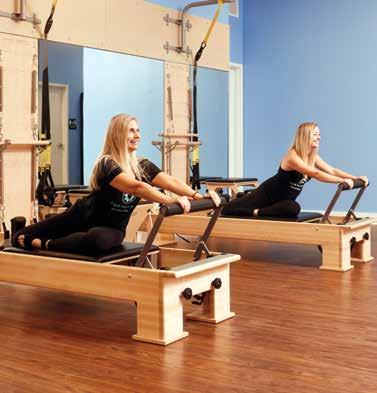
6 minute read
Calling All Defenders of Wildlife
from FF June 2020
by Forsyth Mags
PART 4: The Henslow Sparrow
BY LISA S.T. DOSS
Advertisement
The diversity of North Carolina’s three sub-biomes, namely the coastal plains, Piedmont, and the mountains, reveals varieties of forest and non-forest ecosystems. Based on our consistent levels of precipitation and four distinct seasons, we live in the biome of a temperate deciduous forest. It’s no wonder our climate attracts diverse species of colorful birds and smaller mammals, as well as dangerous creatures, from the rattlesnake to the southern black widow spider. In the mountain regions, outside Winston-Salem, live black bears, bobcats, and coyote. And, perhaps the cougar is not extinct, but resurging in numbers. Unless searching for specific names of birds, insects, aquatic vertebrae, and mammals in the Piedmont Triad, you’ll not be aware of the creatures that no longer fly, swim, or walk here. In calling all defenders of wildlife, it’s essential to know why our ecosystem is on the verge of losing the Henslow sparrow.
PREFERENCES
Not all birds perch in limbs high above the ground and flit from one spot to the next. A bird that is distinguishable by its flat head, brown-streaked breast, and short tail engages in a unique foraging habit. Male and females enjoy running through grassy fields to feast on insects, such as grasshoppers and beetles, stink bugs, small wasps, snails and spiders. Only when confronted by a predator will the small sparrow choose to expand its eight-inch wingspan and fly. An inconspicuous songbird spanning only four to five inches in length, it is a rare gift to spot the Henslow; yet, if camping in an area of saplings, you may hear a short hiccup call, sounding similar to the word, “si-lick” from dusk through to dawn.
NORTH CAROLINA A PRAIRIE?
It is difficult to imagine the Piedmont Triad once had areas where tall native grasses swayed in the breezes, reaching shoulder height, with thriving streams and ponds. Dating back 100 years, little bluestem, Indian grass, prairie anemone, and larkspur grew. Forests were narrow and full of young saplings. It was a time when species like the Henslow sparrow could locate breeding areas and plenty of food sources. Then in an ideal setting of flowering plants, pollinators, and wildlife, like the Bobwhite quail, human population increases altered open areas to make room for subdivisions and commercial properties.
CONSERVATION PROJECTS UNDERWAY
Today, there are acres of prairie ecosystems in Raleigh, Durham, and Charlotte to help visitors, junior scientists, and all defenders of wildlife understand the need for a natural landscape. The prairies of open, sundrenched grasslands may return. The Piedmont Prairie Partnership, alongside non-profit, state, and federal agencies are openly talking about bringing back our reserves. Our fear of losing more wildlife, such as the Henslow sparrow, will take a collective effort to alleviate, which includes you!
AIDING THE HENSLOW SPARROW POPULATIONS
A walk through a natural habitat, such as a thriving prairie, forest, stream, or pond allows you to see firsthand how plants and animals adapt. Although not as spacious as a natural reserve, there are forms of ecosystems we can create by planting native trees and wildflower plots. Ornamental grasses add contrast to a perennial bed. Consider planting switchgrass, pampas, pink Muhly, Maiden Grass, little bluestem, Sapphire blue oat grass, and silver feather grass.
The term “natural” contrasts with the mindset of wanting a perfectly manicured lawn and trimmed edges; yet, “wild” can also exist to welcome a variety of songbirds, insects, and mammals. Once established, you can start to sit back and enjoy the wildlife arriving at your landscape. Do not forget to add two of the essential needs, shelters and water!
CLUB PILATES

CLUB PILATES ®

Fitness for Everyone
BY DENISE HEIDEL PHOTOGRAPHY BY JEJ PHOTOS
Pilates is far from new, but Club Pilates of Winston-Salem is. And, despite the challenges of being a brand new business in a COVID-19 world, Club Pilates is taking the community by storm.
BUT FIRST, WHAT IS PILATES? Pilates is an exercise technique that was created by Joseph Pilates. Born in Germany, Joseph Pilates began experimenting with different types of resistance exercises as early as 1912. He began to develop a following before he immigrated to the United States in 1926 and opened a fitness studio in New York. The rest is history. Even 53 years after his death, his name and his legacy live on in the fitness community.
WHY CLUB PILATES? For Club Pilates Winston-Salem’s owner, Kristin Henry, the choice was easy. She has been working in the fitness industry since 2011, including her role as a Pilates Master Trainer. Of all the fitness styles she taught, Pilates always helped her move and feel her best. After years of teaching, she wanted to bring those benefits to more people. The Club Pilates method allows members to get exceptional instruction, using top of the line equipment, while ensuring the workout is accessible to everyone.
THE CLUB PILATES DIFFERENCE: PILATES IS FOR EVERYONE “One of the main comments we hear from our members is that our club is so inviting,” said Kristin. “Pilates isn’t meant to be intimidating, but let’s face it – some of our workout equipment can look a little intense! Our teachers make sure everyone feels comfortable and confident in class while getting a great workout. We pride ourselves on offering an approachable environment that is friendly and engaging for everyone!”
Kristin shared, “Pilates is for anyone. If you move – Pilates is for you! It’s an exercise program that is wholeheartedly embraced by dancers and competitive athletes, but it’s truly a program for anyone who simply wants to move and feel better. Since starting, our members have shared that they have improved flexibility, core strength and balance. Many have also reduced their chronic pain and even grown taller!”
At Club Pilates Winston-Salem, beginners don’t need to feel excluded. “Our trainers are adept at adjusting and modifying movements for everyone in the group,” explained Kristin. “We want everyone to enjoy Pilates, and so our job is to make sure you start where you are and grow from there! Our online class schedule explains the various options, and we have classes that meet all day, starting as early as 6am and going as late as 7pm. The classes are 50 minutes, and with our central location, we can really make things work for anyone’s schedule. We offer private, semi-private and group classes.”
CLUB PILATES TRAINING “As a Pilates Master Trainer, I am so excited to offer Teacher Training!” Kristin shared, “Pilates is my passion, and I’m thankful that I have been able to make a career out of it! And, for those who are interested in teaching Pilates, we offer that! We are always looking for caring and compassionate individuals who love to move! And, once we find that spark, we can teach them the technical aspects of Pilates.”
“Our Teacher Training Program is a 500-hour comprehensive education program that thoroughly addresses how our equipment is used and how to work with members. So, prior experience is not needed! We’re going to teach an

interested candidate everything they need to know about Pilates and how to teach it! Five hundred hours may sound like a lot,” said Kristin, “but training can be done within a few months. We are excited to mentor those who are eager to make Pilates a part of their career!”
CLUB PILATES IN A COVID-19 WORLD “The impact of COVID-19 has taken a tremendous toll on all businesses – both new and established. We have been so fortunate, though. Even though we had not been open long











